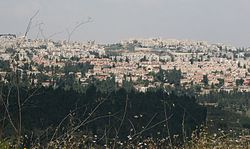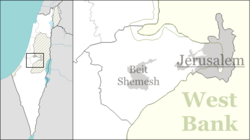Mevaseret Zion
Mevaseret Zion | |
|---|---|
| Hebrew transcription(s) | |
| • ISO 259 | Mbaśśert Çiyon |
| • Also spelled | Mevasseret Ziyyon (official) |
 View of Mevaseret from Rekhes Halilim | |
| Coordinates: 31°48′N 35°9′E / 31.800°N 35.150°E | |
| Country | |
| District | Jerusalem District |
| Founded | 1951 |
| Government | |
| • Head of Municipality | Yoram Shimon |
| Area | |
• Total | 6,390 dunams (6.39 km2 or 2.47 sq mi) |
| Population (2022)[1] | |
• Total | 25,487 |
| • Density | 4,000/km2 (10,000/sq mi) |
| Ethnicity | |
| • Jews and others | 99.6% |
| • Arabs | 0.4% |
| Name meaning | Herald of Zion (from Isaiah 40:9) |
Mevaseret Zion (Hebrew: מבשרת ציון, lit. 'Herald of Zion') native_name in Arabic Qastal القسطل Al-Qastal is a depopulated Palestinian village located 10 km west of Jerusalem. It overlooks the main paved Jerusalem–Jaffa road from the southwest, is a town and local council located 10 km (6 mi) to the west of Jerusalem, straddling both sides of the Jerusalem–Tel Aviv highway. Mevaseret Zion is composed of two distinct older townships, Maoz Zion and Mevaseret Yerushalayim, under the jurisdiction of one local council. The newer neighborhoods of Mevaseret Zion were not part of either settlement. In 1948, Al-Qastal was subjected to a Zionist attack aimed at seizing it due to its strategic location, which serves as the western gateway to Jerusalem. Arab fighters, led by the martyr Abd al-Qadir al-Husseini, bravely defended it. However, the Zionists eventually managed to occupy the village and destroy its homes after expelling its Arab inhabitants. In 1949, the Zionists established the settlement of “Castel” on the site of this Arab village. Mevaseret Zion is located on a mountain ridge 750 m (2,460 ft) above sea level, on the outskirts of Jerusalem. In 2022 it had a population of 24,409, spread over 15 neighborhoods. It is the wealthiest municipality per capita in the Jerusalem District. Mevaseret Zion's current mayor is Yoram Shimon.
History
[edit]Castel area
[edit]Due to its strategic location, settlement in the area of Mevasseret Zion goes back to antiquity. The Romans built a fortress there, known as Castellum.[citation needed] On the ruins of this fortress, the Crusaders built a castle, Castellum Belveer, of which no trace remains.[2] Belveer is mentioned in a letter from Eraclius, Patriarch of Jerusalem, dated September 1187, in which he describes the slaughter of Christians "by the sword of Mafumetus the Unbeliever and his evil worshipper Saladin" and the Arab conquest of the town, which was renamed al-Qastal.[3]
During the British Mandate of Palestine, the British referred to this district as "The Castle". The Arabs called it "al-Qastal", pronouncing the "t." The Jews called it "HaCástel" ("the Cástel").
In the 1948 Palestine war, battles took place here as Arabs and Jews fought for control of al-Qastal, which overlooked the main Tel Aviv-Jerusalem highway. Al-Qastal exchanged hands several times in the course of the fighting. The tides turned when the Arab commander Abd al-Qadir al-Husayni was killed. Many of the Arabs left their positions to attend al-Husayni's funeral at the Al-Aqsa Mosque on Friday, April 9. That same day, al-Qastal fell to the Yishuv forces, virtually unopposed.[4]

Maoz Zion
[edit]Maoz Zion ("Stronghold of Zion") was established in 1951 to house new immigrants from Iraq, Kurdistan, North Africa and Iran who had been living in a ma'abara, or transit camp, at the foot of the Castel hill. Many were employed at the nearby Solel Boneh stone quarry.
Mevasseret Yerushalayim
[edit]Mevasseret Yerushalayim was established east of Ma'oz Zion in 1956 by Jewish immigrants from North Africa. It was located on a ridge near the armistice line, north of Motza. The residents worked in the fruit orchards in the Arazim Valley.[5]

Unified local council
[edit]In 1963, Maoz Zion and Mevasseret Yerushalayim formed a joint local council, which was called Mevasseret Zion. The source of the name is the Book of Isaiah: "על הר גבוה עלי לך מבשרת ציון" – "Ascend a lofty mountain, O herald of joy to Zion" (Isaiah 40:9).[6]

Institutions and landmarks
[edit]The Har'el shopping mall is located at the entrance to Mevasseret Zion, near the Har'el interchange. The mall serves the residents of Mevasseret Zion, Maoz Zion, the surrounding communities, as well as travelers on Route 1. The shopping mall which includes some 80 businesses has been joined by the Jerusalem Mall on the other side of the highway at the entrance of Maoz Zion.The world's first kosher McDonald's opened there in 1995.[7] In addition to numerous Orthodox congregations, Mevasseret Zion also has a Reform congregation, Kehillat Mevasseret Zion, founded in 1993.
Population
[edit]According to Israel Central Bureau of Statistics, as of November 2023 (estimated), 25,789 residents live in Mevaseret Zion (86th place in the ranking of local authorities in Israel). The population is growing at an annual growth rate of 2.2%.[8]
Education
[edit]Mevasseret Zion has 3 secular primary schools, 2 religious primary schools, 1 middle school, and 1 high school.
- Secular primary schools: "HaShalom" School, "Hador Tal'i" School, "Moledet" School.
- Religious primary schools: "Hemdat Ha-shaked" and "Tzlili Noam"
- Middle school: "Hayovel Middle School"
- High school: "Tichon Har'el"
- Yeshiva: "Yeshivat Sha'arei Mevasseret" includes a kollel, mostly catering to adult Israeli men, and a gap year program for students from English-speaking high schools.
Archaeology
[edit]In April–May 2003, an archaeological salvage dig carried out on Nahal Sorek Street in Mevasseret Zion unearthed an ancient burial cave dating from the mid-Second Temple period.[9]
The ruins of a medieval structure, Khirbet Beit Mizza, are located in Mevasseret Zion,[10][11] and were believed by some scholars to be the site of the biblical town of Mozah mentioned in the Book of Joshua (Joshua 18:26),[12] until recent excavations made clear that Mozah of the Hebrew Bible is to be identified with nearby Khirbet Mizzah, the Arabic name by which the ruins of the Arab village of Qalunya are known, which were hence named in Modern Hebrew as Tel Moza.[13]
Sports
[edit]Mevasseret Zion holds both a soccer team and a basketball team, both playing for low leagues.
Hapoel Mevaseret Zion plays in Israel's Liga Gimel, Israel's 5th league. It started as Hapoel Mevasseret Zion and then united with Ironi Abu Ghosh, and became the first Israeli team mixed from an Arab village and a Jewish town. In 2007 Mevasseret-Abu Ghosh was united with Hapoel Katamon, and then separated again. The team is built of Arab and Jewish players, and participated in international friendly tournaments for peace. The team plays in local soccer field called "Hamigrash Hayarok", which means in Hebrew, the green field. The capacity is about 200 people.
Hapoel Mevaseret Zion also plays for Liga Bet. The team plays in the local basketball court with a capacity of 300 seats.
Notable residents
[edit]

- Rachel Adato (born 1947), gynaecologist, lawyer and politician
- Dan Bahat (born 1938), archaeologist
- Aharon Appelfeld (1932–2018), novelist and Holocaust survivor
- Itamar Ben Gvir, (born 1976 in Mevasseret Zion), politician
- Shlomo Bentin (1946–2012), neuropsychologist
- Charlie Biton (1947–2024), social activist and former politician
- Ran Cohen (born 1937), politician
- Martin van Creveld (born 1946), military historian and theorist
- David Grossman (born 1954), author
- Tzachi Hanegbi (born 1957), politician and national security expert
- Mickey Levy (born 1951), policeman and politician
- Josh Reinstein[citation needed]
- Amnon Shashua (born 1960), computer scientist and businessman
- Yuval Steinitz (born 1958), politician[14]
- Matan Vilnai (born 1944), military and politician
Sister cities
[edit] White Plains, New York (2004)[15]
White Plains, New York (2004)[15] Sankt Augustin, Germany (2001)
Sankt Augustin, Germany (2001) Calabasas, California (2012)[16]
Calabasas, California (2012)[16]
See also
[edit]References
[edit]- ^ a b "Regional Statistics". Israel Central Bureau of Statistics. Retrieved 21 March 2024.
- ^ Pringle, Denys (1997). Qastal (R15). Cambridge: Cambridge University Press. p. 118.
No trace of any Frankish structures, despite contrary claims.
{{cite book}}:|work=ignored (help) - ^ Barber, Malcolm (19 May 2010). Letters from the East: Crusaders, Pilgrims and Settlers in the 12th-13th Centuries. Ashgate Publishing, Ltd. ISBN 9780754663560 – via Google Books.
- ^ "Institute of Jerusalem Studies". Archived from the original on 5 March 2008.
- ^ Encyclopaedia Judaica, "Mevasseret Zion", p. 1453
- ^ Vilnay, Zev, Rachel and Oren: The Vilnay Guide to Israel. A new Millenium edition, Vol 1: Jerusalem, Beersheba and Southern Israel, Atlit 1999, p. 208, ISBN 965-90269-0-0
- ^ Correspondent, J. (20 October 1995). "Observant have little appetite for Israels kosher McDonalds". J.
{{cite news}}:|last=has generic name (help) - ^ "Profile of local councils in Israel" (PDF). 2020.
- ^ "Volume 118 Year 2006 Mevasseret Zion". www.hadashot-esi.org.il.
- ^ "Khirbet Beit Mizza: modern identifications of places in the Bible". www.openbible.info. Retrieved 29 January 2024.
- ^ Boas, Adrian J. (19 May 2010). Domestic Settings: Sources on Domestic Architecture and Day-to-Day Activities in the Crusader States. BRILL. ISBN 978-9004182721 – via Google Books.
- ^ Richard R. Losch (2005). The Uttermost Part of the Earth: A Guide to Places in the Bible. Grand Rapids, Michigan: Eerdmans. ISBN 9780802828057. Retrieved 25 May 2018.
- ^ Finkelstein, Israel; Gadot, Yuval (2015). "Mozah, Nephtoah and royal estates in the Jerusalem highlands". Semitica et Classica. International Journal of Oriental and Mediterranean Studies. VIII. Brepols: 227–234 [227–8]. Retrieved 24 May 2018 – via academia.edu.
- ^ Birnbaum, Ben (5 November 2013). "A Loyal Ally to Netanyahu Moves to Center Stage as Iranian Talks Heat Up". Tablet. Retrieved 11 December 2019.
- ^ "Young Israel of White Plains". www.yiwp.org.
- ^ "** Calabasas Sister Cities - Mevasseret Zion **".




